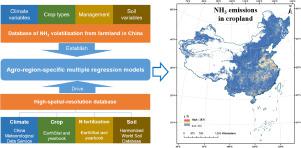Agricultural and Forest Meteorology ( IF 5.6 ) Pub Date : 2021-02-23 , DOI: 10.1016/j.agrformet.2021.108373 Hua Wu , Yunpeng Li , Zihao Xie , Jianfei Sun , Pete Smith , Kun Cheng , Pinhao Fan , Qian Yue , Genxing Pan

|
Estimating ammonia (NH3) volatilization from cropland can identify potential environmental risks and is also important for mitigating NH3 loss, since cropland is the major anthropogenic source of NH3. Reducing uncertainties around NH3 volatilization estimates is a key need. In this study, both a single national model and agro-region-specific models were developed to embody the variation of NH3 volatilization associated with environmental attributes and management practices for cropland in various agro-regions of China. A database with 951 field measurements across China was established to develop and evaluate the model, in which 75% of the measurements were used for model fitting and 25% were used for evaluation. The agro-region specific model had a better performance than the single national scale model, and the agro-region-specific model could successfully simulate NH3 emissions with R2 values of 0.41–0.93 as a function of crop type, N fertilizer type and rate, timing of fertilization, soil pH, clay content, bulk density, precipitation, air temperature, and soil total nitrogen content. Inputting high-resolution spatial data into the model, the NH3 emissions from China's cropland were estimated to be 4.31 Tg NH3 N in the year 2015 with a 95% confidence interval of 3.64–5.64 Tg NH3
N in the year 2015 with a 95% confidence interval of 3.64–5.64 Tg NH3 N, of which paddy rice cultivation accounted for 44%, and maize and wheat cultivation contributed 20% and 16%, respectively. Notable spatial variability was also found in NH3 emissions from China's cropland due to regional differences in climate, soil and management patterns. This study showed that the accuracy of estimation of farmland NH3 emissions can be improved by taking meteorological, soil and management variables into account and inputting high-spatial-resolution data into the modeling.
N, of which paddy rice cultivation accounted for 44%, and maize and wheat cultivation contributed 20% and 16%, respectively. Notable spatial variability was also found in NH3 emissions from China's cropland due to regional differences in climate, soil and management patterns. This study showed that the accuracy of estimation of farmland NH3 emissions can be improved by taking meteorological, soil and management variables into account and inputting high-spatial-resolution data into the modeling.











































 京公网安备 11010802027423号
京公网安备 11010802027423号